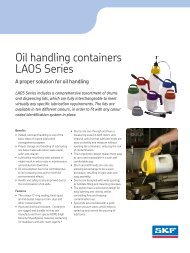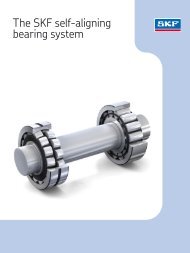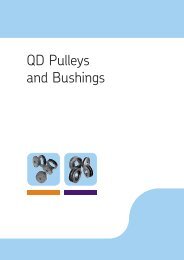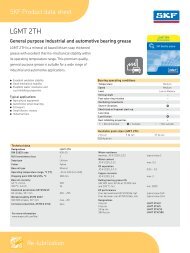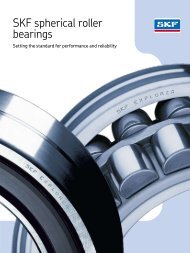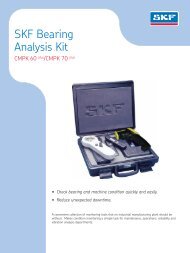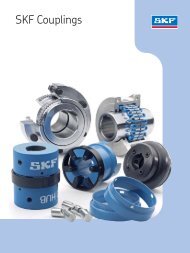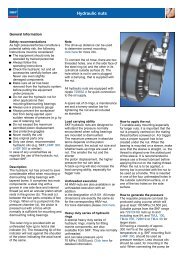SKF Maintenance and Lubrication Products
SKF Maintenance and Lubrication Products
SKF Maintenance and Lubrication Products
You also want an ePaper? Increase the reach of your titles
YUMPU automatically turns print PDFs into web optimized ePapers that Google loves.
The <strong>SKF</strong> Bearing Life Cycle<br />
Help your bearing achieve its maximum service life<br />
Every bearing has a pre-calculated service life. However, research has shown that, for<br />
various reasons, not every bearing achieves it. Important stages which have a major impact<br />
on a bearing service life can be recognised during the bearing’s lifecycle. These stages are<br />
mounting, lubrication, alignment, basic condition monitoring <strong>and</strong> dismounting.<br />
The stages in a bearing life cycle are extremely important for achieving the maximum<br />
service life of the bearing. By applying the right maintenance practices <strong>and</strong> using the correct<br />
tools, you can considerably extend your bearing’s service life <strong>and</strong> increase plant productivity<br />
<strong>and</strong> efficiency.<br />
Mounting<br />
Includes mechanical fitting tools,<br />
induction heaters <strong>and</strong> hydraulic<br />
equipment<br />
<strong>Lubrication</strong><br />
Includes bearing greases, manual <strong>and</strong><br />
automatic lubricators <strong>and</strong> lubrication<br />
accessories<br />
Mounting is one of the critical stages of the bearing’s lifecycle. If the<br />
bearing is not mounted properly using the correct method <strong>and</strong> tools,<br />
the bearing’s service lifetime will be reduced. Individual applications<br />
may require mechanical, heat or hydraulic mounting methods for<br />
correct <strong>and</strong> efficient bearing mounting. Selecting the correct mounting<br />
technique for your application will help you extend your bearing’s<br />
service life <strong>and</strong> reduce costs resulting from premature bearing failure,<br />
as well as potential damage to the application.<br />
Correct bearing lubrication is an essential step in reaching the bearing’s<br />
service lifetime. It is important to select grease suitable for the bearing’s<br />
application, <strong>and</strong> to apply the correct quantity before commissioning the<br />
bearing. During operation, the bearing will require periodic relubrication.<br />
The right quantity of the right grease applied at the right intervals is<br />
essential to achieving optimum bearing performance <strong>and</strong> maximum<br />
service life. Using manual relubrication methods is common practice;<br />
however, continuous relubrication offers many advantages. Continuous<br />
relubrication can be performed by using automatic lubricators, which<br />
provide a more consistent, correct <strong>and</strong> contamination-free grease supply.<br />
Alignment<br />
Includes shaft <strong>and</strong> belt alignment tools<br />
<strong>and</strong> machinery shims<br />
Basic condition monitoring<br />
Includes temperature, sound, visual<br />
inspection, speed, electrical discharge<br />
<strong>and</strong> vibration measuring instruments<br />
After the bearing has been mounted in an application such as a motor<br />
connected to a pump, the application should be aligned. If the application<br />
is not properly aligned, the misalignment can cause the bearing to suffer<br />
additional load, friction <strong>and</strong> vibration. These can accelerate fatigue <strong>and</strong><br />
reduce the bearing’s, as well as other machine components, service life.<br />
Furthermore, increased vibration <strong>and</strong> friction can significantly increase<br />
energy consumption <strong>and</strong> the risk of premature failures.<br />
During operation, it is important to regularly inspect the condition of<br />
the bearing by performing basic condition monitoring measurements.<br />
These regular inspections will allow the detection of potential problems<br />
<strong>and</strong> help to prevent unexpected machine stops. Consequently, the<br />
machine maintenance can be planned to suit the production schedule,<br />
increasing the plant’s productivity <strong>and</strong> efficiency.<br />
2




